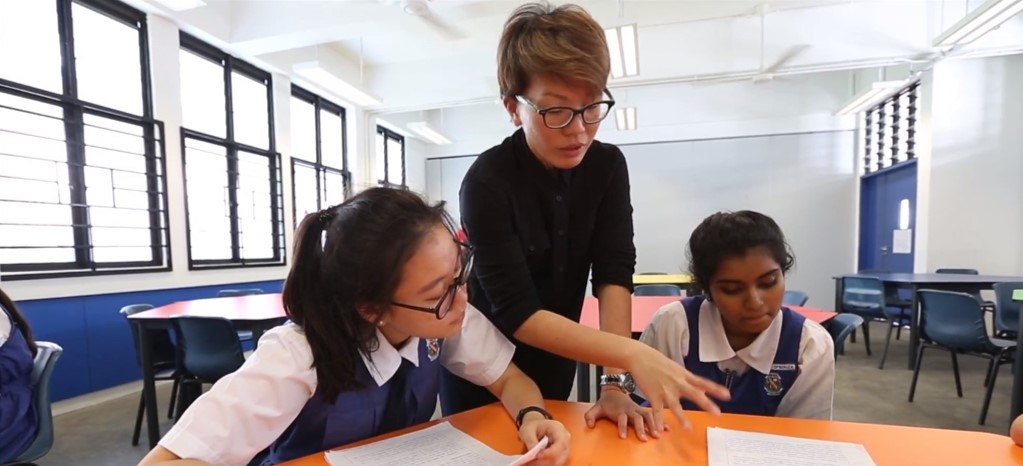Tamil language teacher, Ms Buveneswari Subramaniam, was showing a Primary 2 class a picture showing a mother and daughter browsing in a store selling saris when a feedback struck her like an epiphany. It came from the mentor observing her during her teaching practice: What if, instead of simply describing the action and introducing new words, she could link different strands and ideas from other topics into a lesson?
She realised then, even for a language lesson about retail shopping, she could integrate financial literacy concepts, or discuss localised citizenship issues in stories that are universal.
Bridging links between ideas
“I was using a song in class by a famous Indian poet, Bharathiyar, which was about how a mother cat raised five kittens of different colours,” Ms Buveneswari says. “While the song makes underlying reference to the caste system in India, it was fundamentally about how everyone was the same despite their differences. So, in class, to draw connections with the local context, I discussed with my students about diversity in multicultural Singapore, to guide them to see the big picture of the story.”
Since 2012, Ms Buveneswari has been teaching in Canberra Primary School, and is now the Level Head (Covering) for Tamil Language. The artsy teacher with an inclination towards singing, dancing and performance decided early on that teaching Tamil should always be made fun.
“Some of my students have a fear towards learning Tamil, as they might have come from English-speaking households. To engage them in their learning, I try to teach them in a way that makes them love the subject so they can do well. My main role is to give them positivity, so that they can grasp the language and apply what they have learnt.”
Escape room games in SLS
To inject fun in her lessons, she used the Student Learning Space (SLS) to create escape room-type games. This came about as she had been studying the profiles of her P2 and P6 students and had concluded that they liked discovering things on their own. This was a huge success, especially when the students were at home doing Home-Based Learning. Ms Buveneswari even shared the games with other teachers, who were then inspired to create similar games for their own classes.
“I wanted to create something to help the students revise for the exams, by engaging them in purposeful play,” she explains. “The escape room narratives include different characters—kidnappers, police officers and main protagonist, who is the player. This gets the students excited as they race against time to save someone by answering a series of questions that I’ve set for them, in order to finish their goal. I’ve even recorded my own voice using modulated software to act as different characters, which was quite fun.
“Another platform I’ve used to create games for my students is Deck.Toys, where students have to finish one task after another before proceeding to the next stage. Ultimately, I’m trying to instil self-directed learning for my students. They learn about responsibility as they pick up new words on their own, persevere when making mistakes and then try to get things right to complete the games. This is one of many ways to teach my students about values.”

Photo of Ms Buveneswari’s student engaging in a self-directed game
Language as a window into culture
In Tamil, the word விருந்தோம்பல் (virunthombal) is an important value meaning ‘hospitality’. It is tied closely with tradition and aspects of Indian identity, where language is an entry point into culture.
“When I teach this word to my students,” Ms Buveneswari says, “I talk to them about the value of respect. Even if someone whom you don’t like is entering your home, you have to show them virunthombal – this is a traditional value that has been passed down from generations for many, many years, so you will have to display the value and show this person hospitality.
“This is linked to another concept. A famous female poet Avvaiyar has this proverb, அறம் செய விரும்பு (aram seiya virumbu), meaning the desire to do good, which is sometimes taught in a song. When teaching this, I explain about charity—helping and caring for others—as values inspired from the proverb.”
Role-modelling values
Ms Buveneswari believes students learn best if teachers are positive role models. As such, she ensures she embodies good values herself. “I have taught one student when he was in P2 and then P6. He was known for behavioural issues and resisting learning Tamil.
“It took me a long time to figure out what the problem was. I explained to him that being bilingual is an asset, and we would work together to help him. Slowly, by caring about him, his attitude changed. His Form Teacher and mother saw the difference in him. Now, in Secondary school, he still shares with me about his progress, and I’m glad I was there to help him.
“At the end of the day, kids can tell if teachers are genuine in their care and concern for them. When they tell us we have somehow impacted them positively, without a doubt, this is our best reward.”
*For more information about Mother Tongue Languages, visit the e-MTL Symposium 2020 at www.mtls.edu.sg






